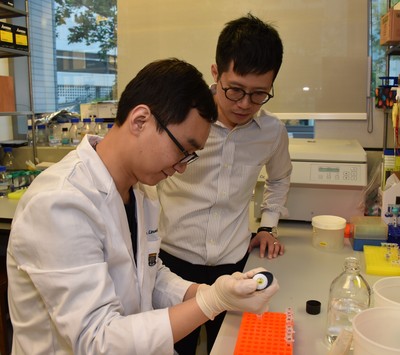HKU and USTC Scientists Discover New Strategy to DNA Repair Control
23 Mar 2017
Safeguarding DNA or its genetic material in human body cells is no easy task. This is because our DNA is under constant attack by a variety of DNA-damaging agents, from reactive oxygen species to UV irradiation from sunlight. Fortunately, our cells have evolved elegant strategies to counteract these otherwise mutagenic events. These include cell-cycle checkpoints and DNA repair, collectively known as DNA Damage Responses (DDRs). Failing to activate DDRs can compromise genome stability, and in turn leads to cell death or at times, neoplastic transformation.
However, as important as it is to promptly repair any damaged DNA, cells only signal for DNA repair when they are in need. Activating DNA repair at the wrong time or at the wrong place can have deleterious outcomes, as illustrated by the established links between hyperactive DNA repair and a cohort of congenital human diseases. Together with other circumstantial evidence, these observations have led to the idea that self-limiting mechanisms must be in place to restrain DDRs, although exactly how cells put DNA repair on a leash is not clear.
Research findings
In 2012 the Huen Laboratory under the School of Biomedical Sciences, Li Ka Shing Faculty of Medicine, The University of Hong Kong (HKU) revealed a cellular strategy that keeps DDRs under stringent control. Dr Michael Shing-Yan Huen, Associate Professor of School of Biomedical Sciences and his team cloned Ring Finger protein RNF169 as one of the key molecules that helps fine-tune DDRs, findings that were also independently reported by two other leading research teams in the field.
“Our identification of RNF169 gave us a lead to understand the exquisite control of DNA damage responses,” said Dr Huen. To delve deeper, the research team undertook a proteomics approach to define the RNF169 “interactome”. In doing so, they identified the Ubiquitin-Specific Protease 7 (USP7) as an important RNF169 regulator. The findings are now reported in Proceedings of the National Academy of Sciences of the United States of America (PNAS).
USP7 is particularly interesting because it has many roles in the cell, including its ability to regulate the abundance of the well-known tumour suppressor p53. By joining efforts with Dr Qingguo Gong, Associate Professor of School of Life Sciences, University of Science and Technology of China (USTC), the two teams teased out precisely how USP7 connects with RNF169, and revealed how the USP7-RNF169 link ensures flawless DNA repair.
“We wanted to find out whether this in vitro relationship between USP7 and RNF169 could also be observed in vivo. Because USP7 is frequently amplified in breast cancers, we wanted to extend our study to examine the expression of USP7 and RNF169 in human breast cancer tissue samples. I therefore approached Professor Ui-Soon Khoo, an expert in breast cancer pathology research, and she generously offered help,” said Dr Huen.
From archived breast cancer specimens, Professor Ui-Soon Khoo, Clinical Professor of Department of Pathology, Li Ka Shing Faculty of Medicine, HKU and her team examined and compared the expression levels of USP7 and RNF169, and were able to demonstrate the striking pattern that links the two proteins. “We found a significant direct correlation between staining intensities of USP7 and RNF169 expression in the nucleus of cancer cells, thus confirming the direct relationship between USP7 and RNF169 in vivo,” described Professor Khoo.
“These findings add substantial value to the study, and suggest that the two proteins may go hand in hand to fuel tumorigenesis,” Dr Huen added. “Cancer cells may develop heightened ability in DNA repair to tolerate genotoxic anti-cancer agents. Whether the USP7-RNF169 connection is one such means awaits further research work.”
Inhibiting USP7 is proving to be an effective way to killing cancer cells in vitro and in animal models. “USP7 inhibitors are moving into clinical trials. Our findings expand the USP7 repertoire and provide a better understanding of the possible pharmacological effects of USP7 inhibitors as potential anticancer therapeutics. Apart from screening small molecules that can specifically drug the USP7-RNF169 interaction, we are also in the process of generating knockout animals to see what happens when RNF169 is missing during normal cell growth and in animal development.”
The work is supported by research fund from Research Grants Council, Committee on Research and Conference Grants (HKU), Outstanding Young Researcher Award (HKU) and National Natural Science Foundation of China.
About the research team of The University of Hong Kong
Dr Michael Shing-Yan Huen heads a research team in the School of Biomedical Sciences, Li Ka Shing Faculty of Medicine, HKU. His major research goal aims to understand the fundamentals of DNA repair processes. Mr Liwei An is a PhD student and a lead author of the publication. Former members of the Huen Laboratory, Dr Jie Chen and Mr Howin Ho-Wang Ng, also contributed to the work.
Professor Ui-Soon Khoo, Clinical Professor of Department of Pathology, Li Ka Shing Faculty of Medicine, HKU specialises in the molecular genetics and genomics of breast cancer. Ms Ellen Pui-Sum Man, the laboratory manager of Prof Khoo’s Breast Cancer Genetics Research Laboratory, also contributed to the work.
About the research team of the University of Science and Technology of China
Dr Qingguo Gong, Associate Professor of School of Life Sciences, USTC, is a structural biologist specialising in NMR and X-ray crystallography. Mr. Yiyang Jiang is a final year PhD student and is also a lead author of the work.
To use the press release photo(s) for any publishing, publicity and related purpose, photo courtesy should be given to “Li Ka Shing Faculty of Medicine, The University of Hong Kong”.

Dr Michael Shing-Yan Huen (left), Associate Professor of School of Biomedical Sciences, Li Ka Shing Faculty of Medicine, HKU and Professor Ui-Soon Khoo (right), Clinical Professor of Department of Pathology, Li Ka Shing Faculty of Medicine, HKU collaborated in this study.

The research team identifies the Ubiquitin-Specific Protease 7 (USP7) as an important RNF169 regulator in fine-tuning DNA damage responses.
